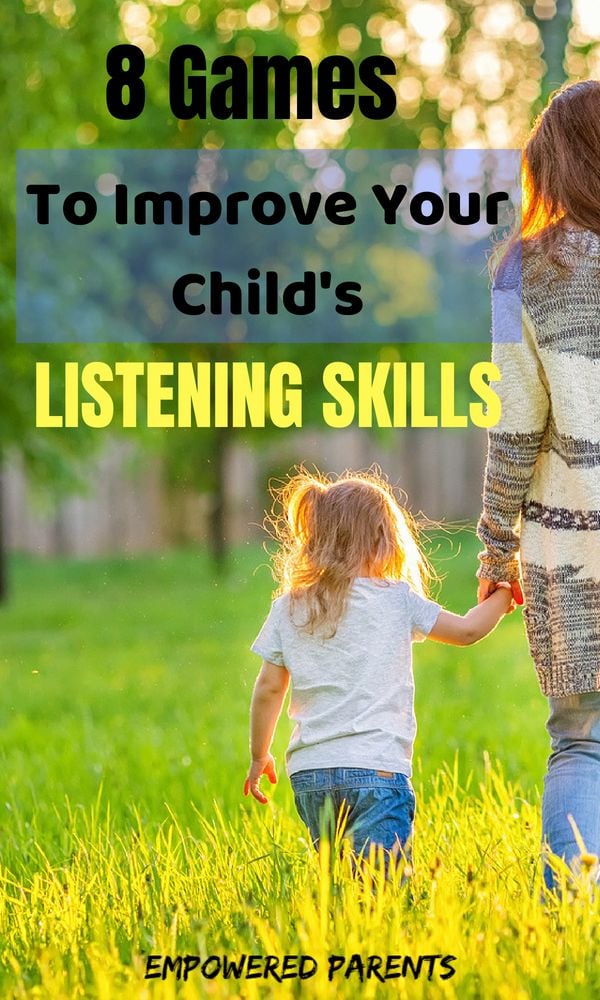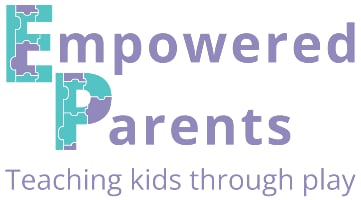Are you looking for fun listening activities for children to do at home or in the classroom?
Listening is one of the most important skills you can teach your children. Although often overlooked, it can be developed easily through simple games and activities.
Listening skills will affect children’s:
- ability to develop speech and language
- ability to read (auditory perception is vital for reading)
- ability to follow verbal instructions at school
- ability to socialise and communicate effectively
- ability to cope at home and at school
Listening can be developed easily through games and activities, which are vital for cognitive growth.
Here are 17 simple activities to get started! I’ve used these activities in the classroom, and the children thoroughly enjoyed them.
There’s also a printable of these activities at the end of this post.
1. Broken Telephone
The Telephone Game can be played at the dinner table or in the classroom.

Begin with single words for very young children and gradually progress to phrases, then complete sentences as their listening skills improve.
Create a word or phrase and whisper it into your child’s ear, who then passes it on to the next family member, continuing to relay the message around the table. The final person to hear the message says it out loud.
This usually ends in laughter, as the phrases often change and the message gets jumbled. In time, your child will be able to listen to details better and convey accurate messages.
Vary the sentences by using alliterations (e.g. my tiny teddy is talking) and rhyming sentences (e.g. do you have a blue shoe?).
Also, change the order of who whispers to whom, and let your children make up their own messages.
2. Simon Says
The classic Simon Says game is excellent for making kids pay attention and listen to instructions.
Provide instructions by saying, for example, “Simon Says put your hands on your shoulders.” When you give an example that doesn’t start with “Simon Says,” such as “Jump three times,” your children must refrain from doing it.
For each instruction, they need to listen for two things:
- whether or not they must follow the command
- what action they need to take
A variation of this game is Do This, Do That.
Standing before children, perform specific actions by saying “do this” or “do that.” For example, you could tap your head, clap your hands or do a jump.
When you say “do this”, your kids must do the action, but when you say “do that”, they must stand still.
Children love this game and often giggle throughout. It takes a lot of concentration not to move and first listen to whether they should perform the action or not.
Here are some fun Simon Says ideas.
3. Musical Statues
The Musical Statues game is another favourite that kids love.

All you need is some music and a space to dance. Play the music and pause it periodically. When the music stops, everyone must freeze.
4. I Went to the Zoo and I Saw a…
This game is more advanced than the previous ones and involves listening and memorising.
Select any animal name and begin the game by saying, “I went to the zoo and I saw a monkey.”
Children respond by saying, “I went to the zoo and saw a monkey and a lion.”
You—or the next child in the group—responds, “I went to the zoo, and I saw a monkey, a lion, and a tortoise.”
For each turn, repeat the animals that have been listed in order, then add a new one. You cannot repeat an animal.
At first, this may be tricky, but with time, you will be amazed at how many animals kids can remember.
This game is actually easier with more people, as it’s simpler to associate words with different individuals than to remember a long list from one person. So be sure to get the siblings, parents and grandparents involved.
After some practice, my six-year-olds could often remember all the words from a class of 20 to 25 children.
This game can be varied with any list, e.g. I went to the shop and I bought a…” or “In my fruit salad there is a…”
5. Which One is the Odd One Out?
‘Which one is the odd one out?’ is a category game that helps children listen for specific information.
Say a string of words that are part of a particular theme or category. Insert one word into the set that does not belong and ask kids to identify the word that doesn’t belong.
Example:
apple, banana, leopard, pear and apricot.
The word leopard is an animal but the rest of the words are types of fruits.
Start with an easy example like this, and later use less obvious categories or choose an odd word from a similar but different category (here’s a list of categories).
For example, say a list of vegetables and insert one fruit, or say a list of negative emotions and add in a positive emotion.
6. What Sound is That?
This is a game of listening to everyday sounds and recognizing what they are.

Blindfold a child or ask them to turn around. Walk around the room and make noises with various everyday items. Ask your children to identify the sounds.
This can be done in any room – a bathroom, kitchen, bedroom, living room or even outdoors. Make sounds such as:
- open the refrigerator door
- switch on the blender
- lift and close the swing dustbin
- take an ice cube out of the tray
- switch on the tap
- peel a banana
- boil the kettle
7. Go on a Listening Walk
This game is great for developing listening skills, encouraging mindfulness, and helping children tune out the constant jumble of thoughts in their heads. Adults should do it too.

Take children for a walk in the garden, playground, down the road or to the park. There are usually enough sounds in your garden!
Tell each other all the sounds you hear – leaves rustling, your dog barking, a car on the motorway, a bird chirping, a child yelling, a siren, etc.
8. How Many Things Did You Hear
This is a variation of the previous game and involves listening as well as memorizing.
Ask children to close their eyes and put a timer on your phone for 30 seconds. Ask them to listen carefully and try to recall all the sounds they heard—in order, if possible.
List all the sounds and count how many different sounds there are. With time, increase from 30 seconds to a minute of focused listening.
9. Listen to Stories
Listen to audiobooks or stories on YouTube without watching the screen. Ask your kids questions about the story.
This also works with bedtime stories. Ask them to close their eyes and listen to you reading the story without showing the pictures. They can imagine how they will draw the story for you in the morning.
10. Give Multiple Instructions
Give kids multiple instructions in the class, around the house or while cooking together. Ensure the instructions are clear.
Start with one instruction. Please fetch the book next to my bed.
Ask them to repeat the instruction back to you, then follow it.
Increase it to two instructions. Please fetch the book next to my bed. Then open it and take out the recipe cut-out from the front cover.
Increase this over time, until you can give 4 or 5 instructions at once. Multiple instructions are frequently given in the classroom, making this a valuable exercise to try at home.
Here are some fun 2-step directions for preschoolers.
11. Ask Questions During Story Time
While reading to children, ask different types of questions to develop their higher-order thinking skills.
Examples include questions that require prediction, problem-solving, understanding cause and effect, discussing character traits, and giving personal opinions.
12. Draw a Picture With Instructions
Adapt the following exercise to your children’s level.
Provide a piece of paper and coloured crayons/pencils. Ask kids to follow your instructions carefully.
This is an enlightening exercise that often clearly shows if listening skills are in place or require some sharpening.
Preschoolers should initially be given very simple instructions, one at a time. Incorporate questions with the words left and right.
Feel free to use this example, simplify it for a preschooler or make up your own.

- Turn your page to landscape.
- Write your name in the top left-hand corner.
- Draw a sun in the top right-hand corner, then draw three clouds at the top of your page, between the date and the sun (multiple instructions in one).
- Draw a tree in the bottom left-hand corner of the page with 4 apples on it.
- In the middle of the page, draw an airplane with 5 windows. Draw a big red stripe on the airplane.
- Draw 3 flying birds on the right-hand side of the airplane.
- Draw some grass on the ground and 3 flowers.
Here are a few more listen-and-draw activity ideas, from easy to challenging.
13. Practise Auditory Analysis and Synthesis
Practise breaking up words by listening to their sounds and substituting letters. This is an excellent activity to help with phonics and reading.
The following activities increase in difficulty:
Repeat each word after me: say mat, say cat, say rat, etc. (rhyming sets)
Repeat two words together, then three, etc: say mat, fat, cat
Remove one word in compound words: Say pancake, now say it again without pan
These exercises can increase in difficulty for older children:
Change the initial sound: Say sad, now change the s to an m – mad
Change the end sound: Say fan, now change the n to a b – fab
Change the middle sound: Say nut, now change the u to an e – net
There are many ways to break up sounds, but these are a few ideas to begin with.
14. Sing Action Rhymes
When children are using their bodies to move, they are concentrating better, learning more and developing better listening skills.
A great listening activity for preschoolers is to teach them an action rhyme where they follow the instructions, such as the one below.

Hands on Shoulders
Hands on shoulders,
hands on knees.
Hands behind you,
if you please;
Touch your shoulders,
now your nose,
Now your hair and now your toes;
Hands up high in the air,
Down at your sides, and touch your hair;
Hands up high as before,
Now clap your hands, one-two-three-four!
15. Make Up an Impromptu Story
At bedtime or during classroom circle time, create a nonsense story together by taking turns adding a line and seeing where it leads.
Adult: Once upon a time there was a little girl.
Child: She was fighting with her brother.
Adult: Suddenly, they heard a big noise and went to the window…
16. Model Good Listening
It goes without saying—if you want your children to be good listeners, you must model that behaviour.
Listen to them when they talk to you. Validate what they are saying.
17. Praise Good Listening
And finally…
Praise your children when they listen well by using specific language.
Try not to default to phrases like ‘what a good boy’. Rather, make statements such as:
Great job listening carefully to all the instructions.
II can tell from your picture that you listened carefully to my instructions.
Well done for making the effort to concentrate today.
I hope you’ve enjoyed these ideas. Here is a list of more early literacy skills children need to develop.
Listening Skills Activities for Kids
Notes
Listening is one of the most important skills you can teach your children. Although often overlooked, it can be developed easily through simple games and activities.
Listening skills will affect children's:
- ability to develop speech and language
- ability to read (auditory perception is vital for reading)
- ability to follow verbal instructions at school
- ability to socialise and communicate effectively
- ability to cope at home and at school
Listening can be developed easily through games and activities, which are vital for cognitive growth.
Here are 17 simple activities to get started! I’ve used these activities in the classroom, and the children thoroughly enjoyed them.
1. Broken Telephone
The Telephone Game can be played at the dinner table or in the classroom.
Begin with single words for very young children and gradually progress to phrases, then complete sentences as their listening skills improve.
Create a word or phrase and whisper it into your child’s ear, who then passes it on to the next family member, continuing to relay the message around the table. The final person to hear the message says it out loud.
This usually ends in laughter, as the phrases often change and the message gets jumbled. In time, your child will be able to listen to details better and convey accurate messages.
Vary the sentences by using alliterations (e.g. my tiny teddy is talking) and rhyming sentences (e.g. do you have a blue shoe?).
Also, change the order of who whispers to whom, and let your children make up their own messages.
2. Simon Says
The classic Simon Says game is excellent for making kids pay attention and listen to instructions.
Provide instructions by saying, for example, “Simon Says put your hands on your shoulders.” When you give an example that doesn’t start with “Simon Says,” such as “Jump three times,” your children must refrain from doing it.
For each instruction, they need to listen for two things:
- whether or not they must follow the command
- what action they need to take
A variation of this game is Do This, Do That.
Standing before children, perform specific actions by saying “do this” or “do that.” For example, you could tap your head, clap your hands or do a jump.
When you say “do this”, your kids must do the action, but when you say “do that”, they must stand still.
Children love this game and often giggle throughout. It takes a lot of concentration not to move and first listen to whether they should perform the action or not.
3. Musical Statues
The Musical Statues game is another favourite that kids love.
All you need is some music and a space to dance. Play the music and pause it periodically. When the music stops, everyone must freeze.
4. I Went to the Zoo and I Saw a…
This game is more advanced than the previous ones and involves listening and memorising.
Select any animal name and begin the game by saying, “I went to the zoo and I saw a monkey.”
Children respond by saying, “I went to the zoo and saw a monkey and a lion.”
You—or the next child in the group—responds, “I went to the zoo, and I saw a monkey, a lion, and a tortoise.”
For each turn, repeat the animals that have been listed in order, then add a new one. You cannot repeat an animal.
At first, this may be tricky, but with time, you will be amazed at how many animals kids can remember.
This game is actually easier with more people, as it's simpler to associate words with different individuals than to remember a long list from one person. So be sure to get the siblings, parents and grandparents involved.
After some practice, my six-year-olds could often remember all the words from a class of 20 to 25 children.
This game can be varied with any list, e.g. I went to the shop and I bought a…” or “In my fruit salad there is a…”
5. Which One is the Odd One Out?
'Which one is the odd one out?' is a category game that helps children listen for specific information.
Say a string of words that are part of a particular theme or category. Insert one word into the set that does not belong and ask kids to identify the word that doesn’t belong.
Example:
apple, banana, leopard, pear and apricot.
The word leopard is an animal but the rest of the words are types of fruits.
Start with an easy example like this, and later use less obvious categories or choose an odd word from a similar but different category (here's a list of categories).
For example, say a list of vegetables and insert one fruit, or say a list of negative emotions and add in a positive emotion.
6. What Sound is That?
This is a game of listening to everyday sounds and recognizing what they are.
Blindfold a child or ask them to turn around. Walk around the room and make noises with various everyday items. Ask your children to identify the sounds.
This can be done in any room – a bathroom, kitchen, bedroom, living room or even outdoors. Make sounds such as:
- open the refrigerator door
- switch on the blender
- lift and close the swing dustbin
- take an ice cube out of the tray
- switch on the tap
- peel a banana
- boil the kettle
7. Go on a Listening Walk
This game is great for developing listening skills, encouraging mindfulness, and helping children tune out the constant jumble of thoughts in their heads. Adults should do it too.
Take children for a walk in the garden, playground, down the road or to the park. There are usually enough sounds in your garden!
Tell each other all the sounds you hear – leaves rustling, your dog barking, a car on the motorway, a bird chirping, a child yelling, a siren, etc.
8. How Many Things Did You Hear
This is a variation of the previous game and involves listening as well as memorizing.
Ask children to close their eyes and put a timer on your phone for 30 seconds. Ask them to listen carefully and try to recall all the sounds they heard—in order, if possible.
List all the sounds and count how many different sounds there are. With time, increase from 30 seconds to a minute of focused listening.
9. Listen to Stories
Listen to audiobooks or stories on YouTube without watching the screen. Ask your kids questions about the story.
This also works with bedtime stories. Ask them to close their eyes and listen to you reading the story without showing the pictures. They can imagine how they will draw the story for you in the morning.
10. Give Multiple Instructions
Give kids multiple instructions in the class, around the house or while cooking together. Ensure the instructions are clear.
Start with one instruction. Please fetch the book next to my bed.
Ask them to repeat the instruction back to you, then follow it.
Increase it to two instructions. Please fetch the book next to my bed. Then open it and take out the recipe cut-out from the front cover.
Increase this over time, until you can give 4 or 5 instructions at once. Multiple instructions are frequently given in the classroom, making this a valuable exercise to try at home.
11. Ask Questions During Story Time
While reading to children, ask different types of questions to develop their higher-order thinking skills.
Examples include questions that require prediction, problem-solving, understanding cause and effect, discussing character traits, and giving personal opinions.
12. Draw a Picture With Instructions
Adapt the following exercise to your children's level.
Provide a piece of paper and coloured crayons/pencils. Ask kids to follow your instructions carefully.
This is an enlightening exercise that often clearly shows if listening skills are in place or require some sharpening.
Preschoolers should initially be given very simple instructions, one at a time. Incorporate questions with the words left and right.
Feel free to use this example, simplify it for a preschooler or make up your own.
- Turn your page to landscape.
- Write your name in the top left-hand corner.
- Draw a sun in the top right-hand corner, then draw three clouds at the top of your page, between the date and the sun (multiple instructions in one).
- Draw a tree in the bottom left-hand corner of the page with 4 apples on it.
- In the middle of the page, draw an airplane with 5 windows. Draw a big red stripe on the airplane.
- Draw 3 flying birds on the right-hand side of the airplane.
- Draw some grass on the ground and 3 flowers.
13. Practise Auditory Analysis and Synthesis
Practise breaking up words by listening to their sounds and substituting letters. This is an excellent activity to help with phonics and reading.
The following activities increase in difficulty:
- Repeat each word after me: say mat, say cat, say rat, etc. (rhyming sets)
- Repeat two words together, then three, etc: say mat, fat, cat
- Remove one word in compound words: Say pancake, now say it again without pan
These exercises can increase in difficulty for older children:
- Change the initial sound: Say sad, now change the s to an m - mad
- Change the end sound: Say fan, now change the n to a b - fab
- Change the middle sound: Say nut, now change the u to an e - net
There are many ways to break up sounds, but these are a few ideas to begin with.
14. Sing Action Rhymes
When children are using their bodies to move, they are concentrating better, learning more and developing better listening skills.
A great listening activity for preschoolers is to teach them an action rhyme where they follow the instructions, such as the one below.
Hands on Shoulders
Hands on shoulders,
hands on knees.
Hands behind you,
if you please;
Touch your shoulders,
now your nose,
Now your hair and now your toes;
Hands up high in the air,
Down at your sides, and touch your hair;
Hands up high as before,
Now clap your hands, one-two-three-four!
15. Make Up an Impromptu Story
At bedtime or during classroom circle time, create a nonsense story together by taking turns adding a line and seeing where it leads.
Adult: Once upon a time there was a little girl.
Child: She was fighting with her brother.
Adult: Suddenly, they heard a big noise and went to the window...
16. Model Good Listening
It goes without saying—if you want your children to be good listeners, you must model that behaviour.
Listen to them when they talk to you. Validate what they are saying.
17. Praise Good Listening
And finally...
Praise your children when they listen well by using specific language.
Try not to default to phrases like ‘what a good boy’. Rather, make statements such as:
- Great job listening carefully to all the instructions.
- I can tell from your picture that you listened carefully to my instructions.
- Well done for making the effort to concentrate today.


Kathryn
Monday 23rd of January 2023
How do you sign up?
Tanja Mcilroy
Monday 23rd of January 2023
Hi Katherine, sign up on this page by following the prompts to download the free activity packs: https://empoweredparents.co/activity-packs-and-printables/
liyana
Sunday 25th of September 2022
based on the activties, the activities are good for children because when we listen , we use our ears to recieve individual sounds ( letter, stress , rythm and pause). we use our brain to convert these into messages that mean something to us.
Naw Elizabeth
Wednesday 31st of August 2022
I want to learn more about how to be a good listener and need more activity.
Tanja Mcilroy
Wednesday 31st of August 2022
Hi Elizabeth, there are many activities and articles on the website to help with listening skills. Find them on this page: https://empoweredparents.co/listening-activities/
ulfah
Thursday 7th of April 2022
great. It's recommended blog
Cecilia
Wednesday 9th of March 2022
Revealing,C